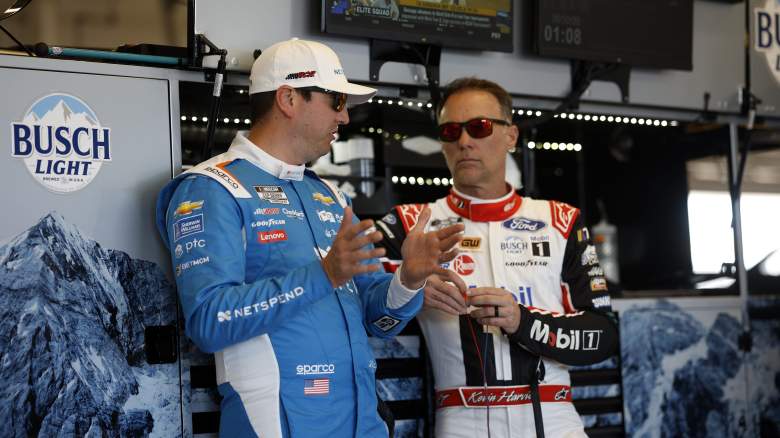
Getty Kevin Harvick (right) has weighed in about the aggressive moves at Circuit of the Americas.
The aggressiveness at NASCAR‘s road courses has been a topic of conversation since the most recent trip to Circuit of the Americas. Now, Kevin Harvick has provided the reason why drivers make these moves.
The veteran driver provided insight in a release from Stewart-Haas Racing. He explained that the durability of the cars, the SAFER Barrier, and the number of available resources have all led to changes in how drivers race each other. Though he also pointed out the role that racing education plays as drivers grow older.
“Today, I really see it at the go-kart tracks,” Harvick said. “The things you currently see on the racetrack are exactly how all of them are taught to race. They’re taught to block, they’re taught to race in the rain, they’re taught to run into you and they’re taught to gouge on the restarts, and that’s just the way it is.
“It’s just a different upbringing as far as how you teach them to race compared to how I was taught to race, and there are a lot more situations where everybody has the resources and cars to get to the racetrack than putting your car together on a week-to-week basis where if you didn’t finish, you didn’t get to go for a few weeks. It’s a much different era of racing than what it used to be.”
Harvick Had His Own Issues at Another Road Course

GettyKevin Harvick waves to fans at Circuit of the Americas.
The 2014 Cup Series champion speaks from a place of experience. He has been on the wrong end of these aggressive moves, which led to him trying to deliver payback to several different drivers.
The standout incident occurred at Indianapolis Motor Speedway in 2022. Harvick needed a strong performance to put himself in contention for a playoff spot, but he was sent spinning after exiting Turn 1.
Harvick entered Turn 1 in the 13th position, but he left Turn 2 behind the entire field after getting run over. He had to quickly turn around and try to regain as many spots as possible over the final 62 laps.
Harvick’s radio communication featured him asking which drivers had sent him spinning. His team told him that there were about five involved, which prompted him to ask for the names of all five drivers so he could take them all out.
Harvick was not able to accomplish this goal, but he did punt some drivers out of the way. One prominent example was Alex Bowman, who had been pushed into the No. 4 during the big pileup.
The other road course races have featured similarly aggressive moves, which led to several drivers getting knocked out of contention for a strong finish. For example, contact between Chase Briscoe and Ross Chastain started a chain reaction that ended with Daniel Suarez and Martin Truex Jr. getting dropped outside of the top 20.
“Well, the driver code is not what it used to be when I first started — when you would run into the back of somebody on a restart and lift their tires up off the ground because the nose was only eight, nine, 10 inches off the ground,” Harvick said.
“It was much different then because there was a race etiquette that Ken Schrader and Bobby Hamilton and Dale Earnhardt and Mark Martin made sure that you understood. Usually, it came in ways of not being able to get your lap back when the caution came out. They would race you back to the yellow if you weren’t doing things appropriately on the racetrack.”
NASCAR Officials Provided Interesting Comments About Aggressiveness
One part of the conversation about road course aggressiveness has focused on NASCAR. There have been questions about whether the officials will make any changes at future events, such as implementing single-file restarts.
Based on comments from NASCAR SVP of Competition Elton Sawyer, there are not any changes on the way. He appeared on SiriusXM NASCAR Radio after the trip to COTA and indicated that aggressiveness is part of NASCAR’s DNA.
“We didn’t see anything that crossed the line,” Sawyer said on March 28. “Our DNA for 74-plus years has been aggressive driving. I think what we see today — and a little bit of a byproduct, which is still good — is the durability of our Next Gen car. And our drivers know that, so they can even be more aggressive.”
Sawyer continued and said that there is a line and that the teams and drivers know where this line is. He said that the sanctioning body will get involved if they see something “blatantly” obvious, but this is not a desire.